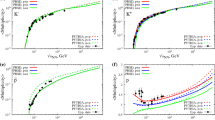Abstract
Based on the quark-hadron duality concept the hadronization of the deconfined matter arising in high-energy particle collisions is considered. The number of generated hadrons is shown to be entirely determined by the exact non-equilibrium Green’s functions of partons in the deconfined matter and the vertex function governed by the probability of the confinement-deconfinement phase transition. Compactifying the standard (3 + 1) chromodynamics into \({\text{QC}}{{{\text{D}}}_{{xy}}} + {\text{QC}}{{{\text{D}}}_{{zt}}}\), the rate of hadrons produced in particle collisions with respect to both the rapidity and \({{p}_{{\text{T}}}}\) distributions is derived in the flux tube approach. Provided that the hadronization is the first order phase transition, the hadron rate is derived in the explicit form. The obtained rate is found to depend strongly on the energy of the colliding particles, number of tubes, hadron mass as well as on the temperature of the confinement-deconfinement phase transition. In the case of the pion production in \(pp\) collisions we obtain a good agreement to the experimental results on the pion yield with respect to both the rapidity and \({{p}_{{\text{T}}}}\) distributions.




Similar content being viewed by others
REFERENCES
B. I. Abelev et al. (STAR Collab.), “Strange particle production in pp collisions at \(\sqrt s = 200\,\,{\text{GeV}}\),” Phys. Rev. C 75, 064901 (2007).
A. Adare et al. (PHENIX Collab.), “Nuclear modification factors of \(\phi \) mesons in d + Au, Cu + Cu, and Au + Au collisions at \(\sqrt s = 200\,\,{\text{GeV}}\),” Rev. C 83, 024909 (2011).
G. Aad et al. (ATLAS Collab.), “Charged-particle multiplicities in pp interactions measured with the ATLAS detector at the LHC,” New J. Phys. 13, 053033 (2011).
V. Khachatryan et al. (CMS Collab.), “Charged particle transverse momentum spectra in pp collisions at \(\sqrt s = 0.9\;{\text{and}}\;7\,\,{\text{TeV}}\),” J. High Energy Phys. 08, 086–124 (2011).
K. Aamodt et al. (ALICE Collab.), “Transverse momentum spectra of charged particles in proton-proton collisions at \(\sqrt s = 900\,\,{\text{GeV}}\) with ALICE at the LHC,” Phys. Lett. B 693, 53—68 (2010).
N. Abgrall et al (NA61 Collab.), “Measurement of negatively charged pion spectra in inelastic p + p interactions at \({{p}_{{{\text{lab}}}}}\) = 20, 31, 40, 80 and 158 GeV/c,” Eur. Phys. J. C 74, 2793 (2014).
C. Y. Wong. Introduction to High-Energy Heavy-Ion Collisions (World Scientific, Singapore, 1994).
S. Dalley, “Adjoint QCD in two-dimensions and non-abelian Schwinger mechanism,” Phys. Lett. 418, 160—171 (1998).
B. Andersson, G. Gustafson, G. Ingelman, and T. Sjöstrand, “Parton fragmentation and string dynamics,” Phys. Rep. 97, 31—145 (1983).
L. McLerran, “The color glass condensate and small-x physics,” Lecture Notes Phys. 583, 291—316 (2002).
L. McLerran, “CGC and the Glasma: Two lectures at the Yukawa Institute,” Prog. Theor. Phys. Suppl. 187, 17—30 (2011).
A. V. Koshelkin and C.-Y. Wong, “The compactification of \({\text{QC}}{{{\text{D}}}_{4}}\) to \({\text{QC}}{{{\text{D}}}_{2}}\) in a flux tube,” Phys. Rev. D 86, 125026 (2012).
W. Melnitchouk, R. Ent, and C. E. Keppel, “Quark-hadron duality in electron scattering,” Phys. Rep. 406, 127—301 (2005).
E. M. Lifshitz and L. P. Pitaevskii, Physical Kinetics (Pergamon Press, Oxford, 1980).
A. Casher, J. Kogut, and L. Susskind, “Vacuum polarization and the absence of free quarks,” Phys. Rev D 10, 732—745 (1974).
J. Schwinger, “Gauge invariance and mass. II”, Phys.Rev. 12, 2425–2429 (1962).
E. Witten, “Nonabelian bosonization in two dimensions,” Commun. Math. Phys. 92, 455—472 (1984).
R. J. Fries, B. Muller, C. Nonaka, and S. A. Bass, “Hadronization in heavy-ion collisions: Recombination and fragmentation of partons,” Phys. Rev. Lett. 90, 202303 (2003).
R. C. Hwa and C. B. Yang, “Recombination of shower partons at high \({{p}_{{\text{T}}}}\) in heavy-ion collisions,” Phys. Rev. C 70, 024905(2004).
E. M. Lifshitz and L. P. Pitaevskii, Statistical Physics (Pergamon Press, Oxford, 1979).
V. V. Slezov, Kinetics of First-Order Phase Transitions (Wiley-VCH, Weinheim, 2009).
L. D. Landau and E. M. Lifshitz, The Classical Theory of Fields (Pergamon Press, Oxford, 1971).
S. R. de Groot, W. A. van Leeuwen, and Ch. G. van Weert, Relativistic Kinetic Theory (North-Holland, Amsterdam, 1980).
E. Fermi, “High energy nuclear events,” Prog. Theor. Phys. 5, 570583 (1950).
Author information
Authors and Affiliations
Corresponding author
Ethics declarations
The author declares that he has no conflicts of interest.
Rights and permissions
About this article
Cite this article
Koshelkin, A.V. Hadron Production in High-Energy Particle Collisions. Phys. Part. Nuclei 53, 233–241 (2022). https://doi.org/10.1134/S1063779622020411
Received:
Revised:
Accepted:
Published:
Issue Date:
DOI: https://doi.org/10.1134/S1063779622020411



